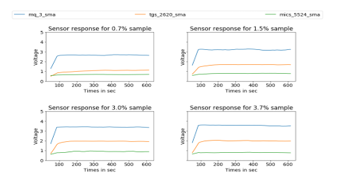Development of Urine Alcohol Content Predicting System Using Machine Learning Based on the Electronic Nose
Keywords:
electronics nose, urine alcohol content, regression model machine learningAbstract
Because many countries still rely on alcohol due to strong drinking cultural practices, efforts to minimize its detrimental usage are more difficult even though alcohol can affect public health. As a result, a device to track alcohol consumption is needed. This research developed an electronic nose based on Internet of Things (IoT) as a new potential tool for measuring the alcohol content in the human body from urine odor. The electronic nose prototype used three gas sensors and was tested using simulated urine that had nine predetermined alcohol contents. We developed several regression models for predicting urine alcohol content using machine learning algorithms, including linear and non-linear algorithms. Based on our experiments, we can reach satisfied results with Support Vector Regression (SVR) (MSE = 0.009) and Random Forest (MSE = 0.014). The results make the electronic nose prototype suitable for measuring the alcohol content in urine.
Downloads
References
Batra A, Müller CA, Mann K, Heinz A. Alcohol Dependence and Harmful Use of Alcohol. Dtsch Arztebl Int 2016;113:301–10. https://doi.org/10.3238/arztebl.2016.0301.
Madden M, Morris S, Stewart D, Atkin K, Gough B, McCambridge J. Conceptualising alcohol consumption in relation to long-term health conditions: Exploring risk in interviewee accounts of drinking and taking medications. PLoS One 2019;14:1–20. https://doi.org/10.1371/journal.pone.0224706.
Coomber K, Mayshak R, Curtis A, Miller PG. Awareness and correlates of short-term and long-term consequences of alcohol use among Australian drinkers. Aust N Z J Public Health 2017;41.
Cotter T, Perez D, Dunlop S, Kite J, Gaskin C. Knowledge and beliefs about alcohol consumption, longer-term health risks, and the link with cancer in a sample of Australian adults. N S W Public Health Bull 2013;24:81–6. https://doi.org/10.1071/NB12089.
Hasking P, Shortell C, Machalek M. University students’ knowledge of alcoholic drinks and their perception of alcohol-related harm. J Drug Educ 2005;35:95–109. https://doi.org/10.2190/9Y34-F5XR-AQV5-KEL8.
Andresen-Streichert H, Müller A, Glahn A, Skopp G, Sterneck M. Alcohol Biomarkers in Clinical and Forensic Contexts. Dtsch Arztebl Int 2018;115:309–15. https://doi.org/10.3238/arztebl.2018.0309.
Hadland SE, Levy S. Objective Testing: Urine and Other Drug Tests. Child Adolesc Psychiatr Clin N Am 2016;25:549–65. https://doi.org/10.1016/j.chc.2016.02.005.
Santos JP, Lozano J, Aleixandre M. Electronic Noses Applications in Beer Technology. Brew. Technol., InTech; 2017. https://doi.org/10.5772/intechopen.68822.
Modak A, Roy RB, Tudu B, Bandyopadhyay R. A novel fuzzy based signal analysis technique in electronic nose and electronic tongue for black tea quality analysis. IEEE; 2016.
Wang Y, Jia P, Cui H, Peng X. A Novel Regression Prediction Method for Electronic Nose Based on Broad Learning System. IEEE Sens J 2021;21:19374–81. https://doi.org/10.1109/JSEN.2021.3090449.
Fadholi GUMELAR S, Mustafa BUDIYANTO H, Fawwaz MAYDA M, Alldino Ardi SUMBODO B. Exploration of Electronic-Nose Potential as Diabetes Urine Detection using Machine Learning Algorithms. Int J Adv Res Sci Eng Technol 2019;6.
Kim VJ, Okano CK, Osborne CR, Frank DM, Meana CT, Castaneto MS. Can synthetic urine replace authentic urine to “beat” workplace drug testing? Drug Test Anal 2018:331–5. https://doi.org/10.1002/dta.2497.
Shmaefsky B. Artificial Urine for Laboratory Testing-Revisired. JSTOR 2015;57:428–30.
Jones AW. EXCRETION OF ALCOHOL IN URINE AND DIURESIS IN HEALTHY MEN IN RELATION TO THEIR AGE, THE DOSE ADMINISTERED AND THE TIME AFTER DRINKING. 1990.
Jordan Voss HG, Mendes Júnior JJA, Farinelli ME, Stevan SL. A prototype to detect the alcohol content of beers based on an electronic nose. Sensors (Switzerland)2019;19. https://doi.org/10.3390/s19112646.

Downloads
Published
How to Cite
Issue
Section
License

This work is licensed under a Creative Commons Attribution-ShareAlike 4.0 International License.
All papers should be submitted electronically. All submitted manuscripts must be original work that is not under submission at another journal or under consideration for publication in another form, such as a monograph or chapter of a book. Authors of submitted papers are obligated not to submit their paper for publication elsewhere until an editorial decision is rendered on their submission. Further, authors of accepted papers are prohibited from publishing the results in other publications that appear before the paper is published in the Journal unless they receive approval for doing so from the Editor-In-Chief.
IJISAE open access articles are licensed under a Creative Commons Attribution-ShareAlike 4.0 International License. This license lets the audience to give appropriate credit, provide a link to the license, and indicate if changes were made and if they remix, transform, or build upon the material, they must distribute contributions under the same license as the original.





